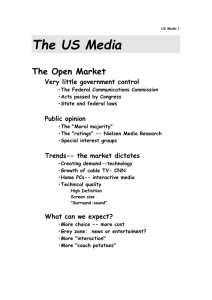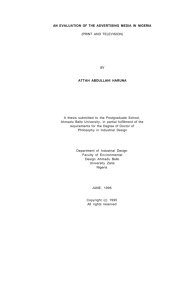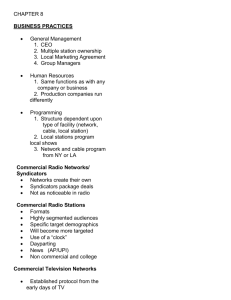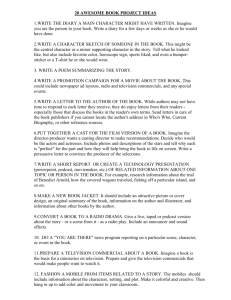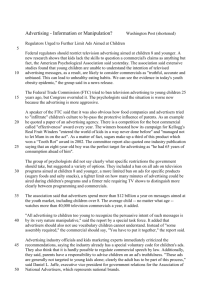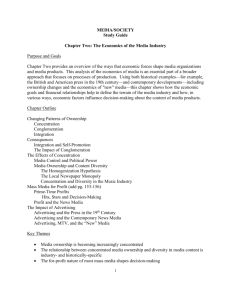i. television - EdYOUcation
advertisement
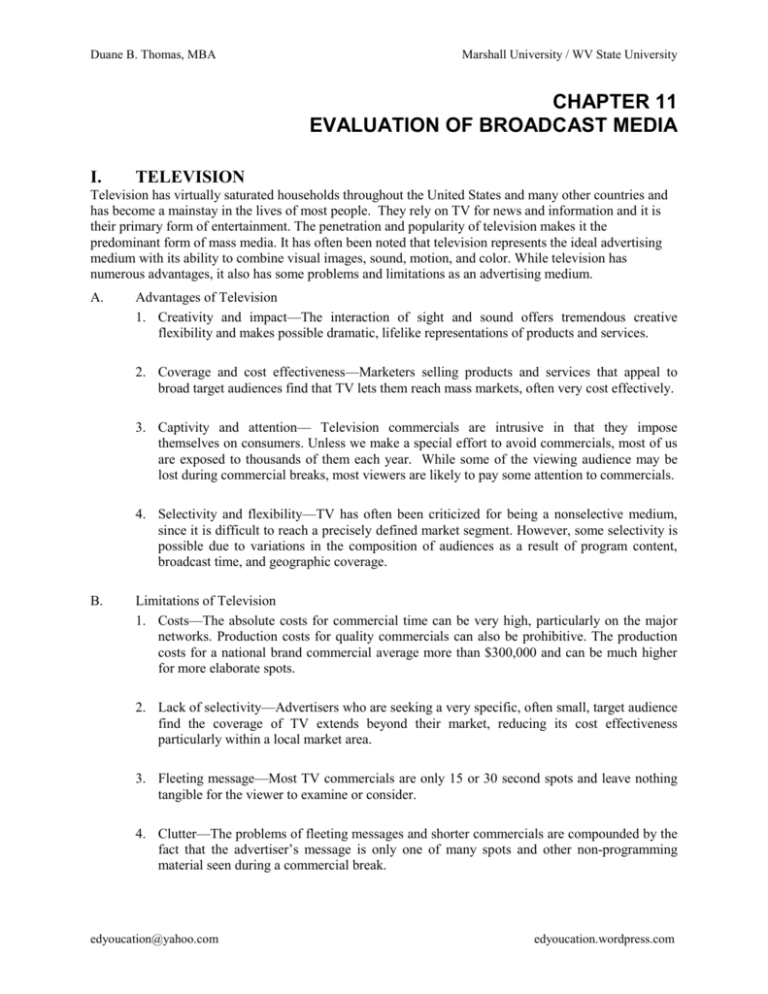
Duane B. Thomas, MBA Marshall University / WV State University CHAPTER 11 EVALUATION OF BROADCAST MEDIA I. TELEVISION Television has virtually saturated households throughout the United States and many other countries and has become a mainstay in the lives of most people. They rely on TV for news and information and it is their primary form of entertainment. The penetration and popularity of television makes it the predominant form of mass media. It has often been noted that television represents the ideal advertising medium with its ability to combine visual images, sound, motion, and color. While television has numerous advantages, it also has some problems and limitations as an advertising medium. A. Advantages of Television 1. Creativity and impact—The interaction of sight and sound offers tremendous creative flexibility and makes possible dramatic, lifelike representations of products and services. 2. Coverage and cost effectiveness—Marketers selling products and services that appeal to broad target audiences find that TV lets them reach mass markets, often very cost effectively. 3. Captivity and attention— Television commercials are intrusive in that they impose themselves on consumers. Unless we make a special effort to avoid commercials, most of us are exposed to thousands of them each year. While some of the viewing audience may be lost during commercial breaks, most viewers are likely to pay some attention to commercials. 4. Selectivity and flexibility—TV has often been criticized for being a nonselective medium, since it is difficult to reach a precisely defined market segment. However, some selectivity is possible due to variations in the composition of audiences as a result of program content, broadcast time, and geographic coverage. B. Limitations of Television 1. Costs—The absolute costs for commercial time can be very high, particularly on the major networks. Production costs for quality commercials can also be prohibitive. The production costs for a national brand commercial average more than $300,000 and can be much higher for more elaborate spots. 2. Lack of selectivity—Advertisers who are seeking a very specific, often small, target audience find the coverage of TV extends beyond their market, reducing its cost effectiveness particularly within a local market area. 3. Fleeting message—Most TV commercials are only 15 or 30 second spots and leave nothing tangible for the viewer to examine or consider. 4. Clutter—The problems of fleeting messages and shorter commercials are compounded by the fact that the advertiser’s message is only one of many spots and other non-programming material seen during a commercial break. edyoucation@yahoo.com edyoucation.wordpress.com Duane B. Thomas, MBA Marshall University / WV State University 5. Limited viewer attention—The increased penetration of DVRs and prevalence of remote control channel changing or zapping is creating a major problem for advertisers. Studies have shown that nearly a third of a TV program’s viewing audience is lost during commercial breaks as they stop watching television or switch to another channel. IMC Perspective 11-1 provides an interesting discussion of new technologies such digital video recorders, (DVRs), Video on Demand (VOD), and Internet Protocol TV will impact the future of television advertising, 6. Distrust and negative evaluation—TV commercials are probably the most criticized form of advertising because of the intrusiveness of the medium. Studies have shown that of the various forms of advertising, distrust is generally the highest for TV commercials. II. BUYING TELEVISION TIME There are a number of options available to advertisers purchasing television time. The instructor should point out that the purchase of television advertising time is a very specialized part of the advertising business, particularly for large companies spending huge sums of money and advertising on a national or regional basis. The various considerations involved in the purchase of television time are examined. A. Network versus Spot—a basic consideration that faces all advertisers is the allocation of their television media budget among network versus local or spot announcements. It is important to cover each of the ways television time can be purchased including: 1. Network advertising—a common way by which advertisers disseminate their messages is by the purchase of airtime from a television network which assembles a series of affiliated stations or affiliates to which its supplies programming. A major advantage of network advertising is that it simplifies the purchasing process for advertisers who want to reach broad target audiences. Most prime-time commercial spots, particularly on the popular shows, are sold during the up-front market while time can also be bought during the scatter market that runs throughout the TV season. 2. Spot and local advertising—spot advertising refers to commercials shown on local television stations, with the negotiation and purchase of time being made directly from the individual stations. All non-network advertising done by a national advertiser is known as national spot, whereas airtime sold to local firms is known as local advertising. 3. Syndication—advertisers may also reach television viewers by advertising on syndicated programs which are sold or distributed to local stations. There are three basic types of syndicated programs: off-network syndication—reruns of network shows that are bought by individual stations first-run syndication—shows produced specifically for the syndication market barter syndication—both off-network and first-run syndicated programs offered free or for a reduced rate to local stations but with some advertising time pre-sold to national advertisers and the remainder available for sale by the local station B. Methods of Buying Time—Television advertisers must also make decisions regarding the method by which they will advertise on a program. The options to be discussed include: edyoucation@yahoo.com edyoucation.wordpress.com Duane B. Thomas, MBA Marshall University / WV State University 1. Sponsorships—under a sponsorship arrangement, an advertiser assumes responsibility for the production and content of the program as well as the advertising that appears within it. Examples of sponsorships include the Kraft Masterpiece Theater and Hallmark Hall of Fame programs that appear on the major networks periodically. 2. Participations—most network advertising time is sold as participations, with multiple advertisers buying commercial time or spots on a program that is produced by the network or an outside production company which sells the show to the network. 3. Spot announcements—spot announcements are bought from the local stations and generally appear during the adjacent time periods of network programs (hence the term adjacencies). Spot announcements are most often used by purely local advertisers but are also utilized by companies with no network schedule or by large advertisers that make dual use of network and spot advertising. C. Selecting Time Periods and Programs—another consideration in buying television time is the selection of the particular time period and program during which the commercial will be shown. Considerations here include the selection of a specific time period or daypart segment and audience size and demographic composition. Common television dayparts are shown in Figure 11-4 of the text. The different dayparts are important to advertisers because they attract different demographic groups. D. Cable Television 1. The growth of cable—Cable or CATV (community antenna television) is probably the most significant development in the broadcast media. By 2005 cable penetration reached 84 percent of the nation’s 110 million households, either through wired cable or alternative delivery systems such as direct broadcast satellite (DBS). Cable channels now have the majority of the prime-time viewing audience and national cable networks such as CNN, ESPN and MTV have become very popular. 2. Advertising on cable—as with broadcast TV, cable can be purchased on a national, regional, or local (spot) basis. Many national advertisers are turning to spot advertising on local cable systems to reach specific geographic markets. Spot cable is also becoming very popular among local advertisers since they find it very affordable. 3. Advantages of cable—cable television has some important advantages including the opportunities it offers for narrowcasting or reaching very specialized markets though stations such as ESPN (sports) MTV (music videos) or CNN (news) and the various other channels. It also offers lower rates and greater flexibility in the types of commercials that can be used. For example, infomercials are often shown on cable television. The low costs of cable make it a very popular advertising medium for local advertisers such as retailers. 4. Limitations of cable- limitations of cable include the fact that it is still overshadowed by the major networks as it has less desirable programming and production than broadcast television. Another drawback is audience fragmentation as the ratings for most cable channels is very low. The prime time program rating for most cable programs is only about 1 or 2. Lack of penetration is also a problem, particularly in some major market areas. edyoucation@yahoo.com edyoucation.wordpress.com Duane B. Thomas, MBA Marshall University / WV State University 5. The future of cable—cable television faces a number of challenges over the next decade such as competition from new channels, continued fragmentation, and changes in government regulation. However, as cable penetration increases and its programming quality continues to improve, more advertisers are discovering its efficiency and ability to reach very targeted market segments. For example, cable has become a very popular source of sports programming and is important to advertisers who want to reach the male market. E. Measuring the TV Audience—One of the most important considerations in using television advertising concerns the size and composition of the TV viewing audience. Audience measurement is critical to the advertiser since they want to know the size and characteristics of the audience they are reaching when they buy time on a particular program. Audience size and composition are important to the network or station as these figures determine the amount they can charge for commercial viewing time. Programming decisions are made on the basis of audience size. 1. Audience measures—the sole source of network TV and local audience information is Nielsen Media Research since Arbitron exited the TV ratings business at the end of 1993 due to steep financial losses. There are some important terms and various types of information the rating services provide which should be covered: a. Television households – the number of households in a market that own a TV. Nielsen estimates that 110 million U.S. household own at least one television set. b. Program rating – the percentage of TV households in an area that are tuned to a specific program during a specific time period. c. Ratings point – a figure that represents 1 percent of the TV households in a particular market tuned to a specific program. d. Households using television (HUT) – the percentage of homes in a given area where TV is being watched during a specific time period. This figure is sometime referred to as sets in use and is always expressed as a percentage. e. Share of audience – the percentage of households watching TV in a specified time period that are tuned to a specific program. Share figure are important because they reveal how well as program does with the available viewing audience. f. Total audience – the total number of homes viewing any five-minute part of a program. 2. Network audience information—the source of national and network television audience information is Nielsen Media Research’s Television Index (NTI) which provides daily and weekly estimates of TV viewing and network program audiences. For many years the audimeter was used as the basis for the famous “Nielsen Ratings.” However, the people meter has become the sole basis for the Nielsen’s national rating system. The people meter is an electronic measuring devices that records not only what is being watched but also by whom in the 10,000 Nielsen households used for the national ratings. 3. Local audience information—Information on local television audiences is provided by the Nielsen Station Index (NSI). These measures are taken using the diary method whereby record what they are programs they are watching and who is watching. Nielsen provides NSI measures in 210 local markets known as designated market areas (DMAs). DMAs are non- edyoucation@yahoo.com edyoucation.wordpress.com Duane B. Thomas, MBA Marshall University / WV State University overlapping areas used for planning, buying and evaluating TV audiences and are generally a group of counties in which stations located in a metropolitan or central area achieve the largest audience share. The ratings period when all 210 DMAs are surveyed is known as the sweeps periods. As discussed in IMC Perspective 11-3, there are many problems with the audience estimates gathered during the sweeps periods and advertising people are calling for changes in this system. 4. Developments in audience measurement—the advertising industry is likely to see changes in the way viewing audiences are measured. Much of the concern over the Nielsen audience measurement numbers involves the use of the diary system to measure local viewing audiences. Nielsen has begun exploring the possibility of expanding the use of people meters to measure local viewing audiences. However, issues such as who will bear the costs of installing the people meters and how much they would add to the costs of Nielsen’s services are still major factors that have to be addressed. The main focus in the future may be on a technology for measuring a rating system for the commercial as well as the program. Concern over the reduction in the size of commercial viewing audiences because of zapping or remote control channel changing is a major factor behind this. Current systems measure the audiences for programs surrounding the commercials rather than the commercials themselves. An alternative system is being tested by Arbitron which uses the portable people meter (PMM) system, which is a pager-sized device that detects an inaudible code embedded in the audio signal of a TV program, radio show or Internet streaming video. Nielsen has an agreement with Arbitron which gives the company the option to develop PPM technology if it goes into commercial production. III. RADIO The role of radio as an entertainment and advertising medium changed dramatically with the rapid growth in the popularity of television. Radio has evolved primarily into a local advertising medium characterized by highly specialized programming which appeals to very narrow segments of the population. Radio has survived and actually grown as an advertising media vehicle because it offers advertisers certain advantages. However, radio does have certain limitations that affect its role as an advertising medium. A. Advantages of Radio 1. Cost and efficiency—Radio commercials are inexpensive to produce and the absolute and relative costs for radio advertising time is generally lower than for television. 2. Selectivity—Radio allows marketers to focus their advertising on specialized audiences such as certain demographic and lifestyle groups. For example, talk radio reaches the adult market effectively while top 40 music reaches teens and young adults. 3. Flexibility—Radio is probably the most flexible of all the advertising media because it has a very short closing period, which means advertisers can change their message almost up to the time it goes on the air. 4. Potential for mental imagery—Radio encourages listeners to use their imagination when processing a commercial message. Radio can also reinforce TV messages through a process called image transfer where the visual elements of TV commercials are implanted in a radio spot. edyoucation@yahoo.com edyoucation.wordpress.com Duane B. Thomas, MBA Marshall University / WV State University 5. Integrated marketing opportunities—Radio provides marketers with a variety of integrated marketing opportunities such as event marketing and point-of purchase promotions. Advertisers often use radio stations and personalities to enhance their involvement with a local market and to gain influence with local retailers. B. Limitations of Radio 1. Creative limitations—Radio is an advertising medium without a visual image. The radio advertiser cannot show the product, demonstrate it, or use any type of visual appeal or information. 2. Audience fragmentation—The percentage of the market tuned to any particular station is usually very small. 3. Chaotic buying procedures—Acquiring information and evaluating and contracting for radio time with even a fraction of the nearly 11,00 commercial stations that operate across the country can be difficult and time consuming. 4. Limited research data—Audience research data on radio are often limited, particularly compared with TV, magazines, and newspapers. 5. Limited listener attention—Radio programming particularly music, is often the background to some other activity and may not receive the listeners’ full attention. Many people who listen in their cars preprogram their radios and change stations during commercial breaks. Another factor that is detracting from radio listening in motor vehicles is the rapid growth of cellular telephones. Commuters who own a cell phone are talking on the phone more and listening to less radio. 6. Clutter—Most radio stations carry an average of nearly 10 minutes of commercials every hour. During the popular morning and evening rush hours, the amount of commercial time may exceed 12 minutes. A new technology called Cash is making it possible for radio broadcasters to reduce the pauses between words of radio announcers and add more time for commercials. C. Buying Radio Time—The purchase of radio time is similar to that of television in terms of purchasing options as advertisers can make either network, spot or local buys during various time periods or dayparts. Various options should be discussed including: 1. Network radio – there are three major national radio networks, Westwood One, ABC, and Premiere. Advertisers can reach a national audience by advertising on one of the networks. 2. Spot radio – national advertisers can use spot radio to purchase airtime on individual stations in various markets. 3. Local radio – most radio advertising is done by local companies who purchase advertising time from stations in local markets. edyoucation@yahoo.com edyoucation.wordpress.com Duane B. Thomas, MBA D. E. Marshall University / WV State University Time classifications—the broadcast day for radio is divided into various time periods or dayparts. The size of the radio listening audience varies widely across the dayparts, and advertising rates follow accordingly. The largest audiences (and thus the highest rates) occur during the early morning and late afternoon weekday drive times. Various dayparts for radio are shown in Figure 11-7. Audience Information—One problem with radio is the lack of audience information that results from the vast number of radio stations with small, fragmented audiences. Developing precise measures of radio listenership is difficult because of the nature of the medium and the many station options available. There are two major radio rating services which should be discussed: 1. Arbitron—covers 260 local radio markets with one to four ratings reports per year by having a sample of representative listeners in each market maintain a diary of their radio listening for seven days. Various figures measured by Arbitron include person estimates, ratings, and share. Arbitron also recently began measuring listenership to webcasts of radio stations. 2. RADAR— another rating service that is now owned by Arbitron and collects audience estimates twice a year for the major radio networks on the basis of 12,000 telephone interviews covering seven day of radio listening behavior. edyoucation@yahoo.com edyoucation.wordpress.com

